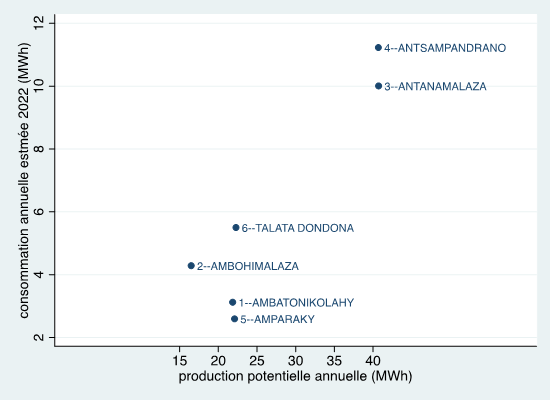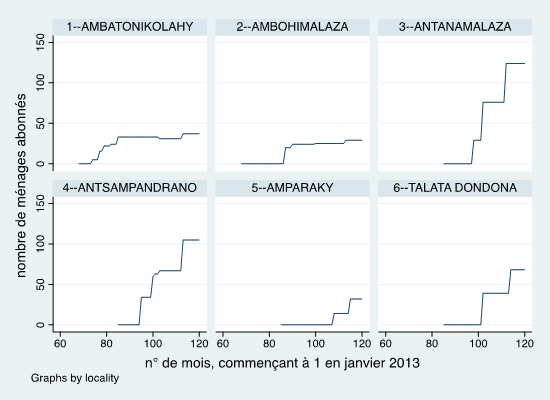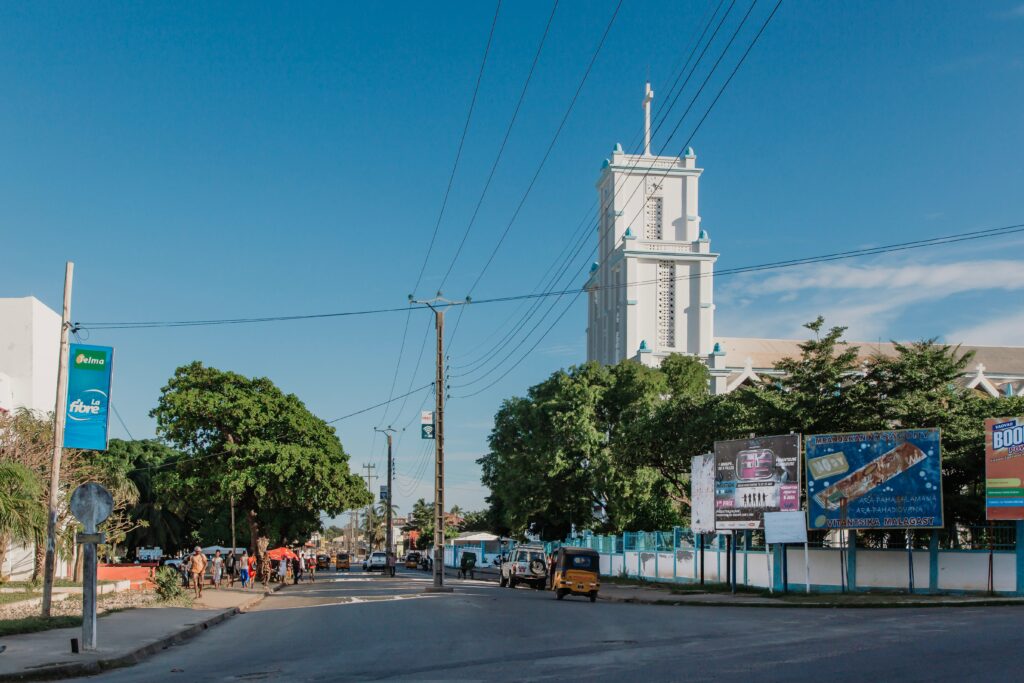In 4 articles for Entreprenante Afrique, we are presenting the Cafés Lumière project in Madagascar and comparing the results of different alternative evaluation methods carried out at an affordable cost to test the existence of positive impacts of the project on development objectives. In this third part, we draw on the activity reports of the operator Anka, which provide, for each equipped locality, a monthly series of electricity consumption data by major type of use, and associated data on the number of customers. We supplement this information with the initial results of the socio-economic surveys conducted in 2017/18 and 2023, in its locality survey section. These data, some of which enable comparisons to be made with control (non-equipped) localities, enable identification of the main transmission channels for access to electricity in relation to sustainable development objectives. This analysis will be supplemented in the fourth part of this blog by the household section of the survey, in which the responses from 50 households per locality will be used to refine the diagnosis by considering the downstream effects of electrification on household well-being.
Overall Performance of Electricity Generation
As demonstrated in the previous article, the Cafés Lumière project has positively influenced access to electricity in the equipped localities. However, it is important to note that this impact may differ from one locality to another. Figure 2 illustrates the effect of Cafés Lumière on electricity provision through the mini-grid by comparing the total annual electricity consumption in 2022 with the production potential of the solar panels (converted into annual MWh).
Figure 1: Potential Electricity Generation and Total Electricity Consumption by Locality in 2022

Figure 1 shows that the higher the wattage of the installation, the greater the amount of electricity consumed, excluding street lighting. However, this correlation does not necessarily imply causation, as the power of the installations was determined based on the population to be electrified. The relatively low ratio between daily consumption and potential generation reflect the non-uniform daily load curve. In the 2023 locality survey, it was frequently noted that the mini-grid often reaches its capacity during peak periods, posing a significant constraint for the few three-phase subscribers.
At Ambatonikolahy and Amparaky, the facilities appear to produce below their potential, possibly due to the limited number of household subscribers, and the largest consumers, as observed elsewhere, are constrained by capacity. In the case of Ambohimalaza, insufficient photovoltaic production during peak times (when the husker is in use) is compensated for by the utilization of the emergency diesel generator. A detailed examination of Anka’s activity reports provides clarification of these observations and also offers an opportunity to compare the progress achieved in the main consumption categories.
Household Consumption
Initially, households benefited from the Cafés Lumière project through the establishment of shops. These shops, functioning as energy kiosks, target individuals who may not have the means to afford a subscription to the mini-network. The income generated from these shops suggests that many households were initially customers in the shop before subsequently subscribing to the mini-grid. While the role of the shops was crucial in the early stages, the main quantitative impact of the project now occurs through the mini-grids.
Figure 2: Growth in the Number of Subscriber Households

Figure 2 illustrates the fluctuations in the number of subscribing households. It is a dynamic scenario with a wide range of situations. With the exception of Cafés Lumière in Ambatonikolahy, Ambohimalaza, and Amparaky, there has been substantial growth in household electricity usage, but this growth is broad rather than intensive (with no significant rise in consumption per subscriber, which is approximately 5 kWh per month). For a tangible economic impact, households will need to augment their electricity usage, expanding beyond domestic lighting consumption to activities that could generate income. Further insights from Anka regarding the structure of electricity consumption in 2023 allows us to observe the start of this dynamic in the next section.
Consumption by Income-Generating Activities
Another significant source of economic impact is the development of income-generating activities (IGAs), the establishment or modernisation of which relies on the use of electricity. From this perspective, the outcomes are varied. Currently, Anka’s activity reports mention very few IGAs, with the highest number, 4, in Antanamalaza. Moreover, most of these activities consume modest amounts of electricity, with the only exceptions being huskers and grinders associated with agricultural activities in Ambatonikolahy, Ambohimalaza, Antsampandrano, and Amparaky. Other diversified activities include bars, carpentry, hairdressing, pastry-making, car painting, fishmonger, and video games.
With a few exceptions, the development of IGAs is slow. Additional data provided by Anka on the current situation at the beginning of 2023 indicates a genuine potential for change. Anka has observed that several households are already using their subscription to power electrical appliances for productive activities without officially registering as entrepreneurs. By mid-2023, there were 32 users of electricity produced by the mini-grid engaged in providing services, including 12 officially declared as IGAs. Among the 20 producers identified in households (constituting 5% of the total subscriber households), a variety of activities are pursued, such as bars, grocers, small restaurants, fruit juice sales, telephone recharging, multiservices, and welding. These activities are present in all localities, and their diversity reflects a certain level of dynamism. It is worth noting that the small restaurants and shops identified in the locality section of our socio-economic survey, on average 5 per locality, are only partially listed as service producers by Anka.
It is not possible to separate the consumption of households engaged in service-producing activities from the overall household consumption, but an approximation can be derived using consumption data for officially declared income-generating activities (IGAs). The consumption of IGA households is markedly higher, approximately 40% more than that of other subscribing households. The expansion of these activities could subsequently drive an increased demand for electricity for productive purposes, thereby enhancing the economic impact of the Cafés Lumière.
Data from the locality section of the socio-economic survey enable a more precise interpretation of these consumption figures. There was no noteworthy increase in the number of service-producing activities, both in the localities electrified by the mini-grid and in the control localities. However, where these activities previously operated, and still do in the control localities, using diesel generators and individual solar panels, almost all of them in the equipped localities have transitioned to the electricity provided by the mini-grid. This marks progress for the equipped localities, and for all the activities that have switched from diesel to the solar mini-grid (on average more than 6 per locality), and it contributes to environmental conservation.
Public services
The last category of electricity consumption identified by Anka is public services, it represents a minority share of the electricity consumed on the mini-grids in 2022. Nevertheless, it can have a significant impact on the achievement of sustainable development goals: health (SDG3), education (SDG4), and peace, justice, and effective institutions (SDG16).
The health objective has garnered considerable attention, with all the basic health centres (CSB2) in the electrified localities (5 CSB2s in 6 localities supplied by the mini-grid) having an average monthly consumption of 23 kWh per CSB2. For comparison, only half of these centres were electrified (via solar panels) in 2017. Currently, all these health centres are equipped with lighting and refrigeration, but the use of electricity to operate medical equipment remains infrequent. In contrast, the situation is markedly different in the control localities, where only half of the health centres have electricity access in 2023, generated by solar panels.
Education is also a focal issue but with more modest aspirations. From a scenario where no school was electrified in 2017, half of the schools in the equipped areas are now electrified, albeit with low consumption (1.8 kWh per month per electrified school). In comparison, none of the schools in the other localities have access to electricity.
The collective activities associated with SDG16, including 8 administrative structures and 10 churches, consumed an average of 8 kWh per month per structure in electrified localities in 2022. In these areas, approximately half of the town halls and police stations are electrified in localities equipped with a mini-grid, while all churches have access to electricity.
Public lighting can also impact MDG16 for security. All localities electrified by Cafés Lumière have invested in public lighting, although not always as a priority, with its connection to the mini-grid sometimes being delayed. Outside Ambatonikolahy and Talata Dondona, the nighttime coverage is limited. Moreover, the Amparaky town council decided against such an investment in 2022 due to perceived high costs (this situation will change in 2023). Overall, in 2022, electrified localities consumed only 12 kWh per month for public lighting, which is less than the consumption for administrative structures or churches.
The availability of public lighting does not significantly differ in localities with a mini-grid compared to control localities, with an average of around 5 streetlights per locality. The mini-grid supplies two-thirds of the streetlights in the concerned localities, but this does not seem to enhance the security situation. The 2 localities with a mini-grid providing extended night lighting do not report any reduction in security problems. The main security issues are linked to crop theft, and it appears that the police activities play a more significant role in improving security.
![]() Further reading in the same serie of articles on “Measuring the Impact of Decentralised Electrification Projects”: Cafés Lumière in Madagascar (1/4), Using Remote Sensing: Initial Results on the Impact of Cafés Lumière (2/4), Characterisation of the Impacts of Decentralised Electrification Projects on Access to Electricity Using Household Data (4/4).
Further reading in the same serie of articles on “Measuring the Impact of Decentralised Electrification Projects”: Cafés Lumière in Madagascar (1/4), Using Remote Sensing: Initial Results on the Impact of Cafés Lumière (2/4), Characterisation of the Impacts of Decentralised Electrification Projects on Access to Electricity Using Household Data (4/4).
